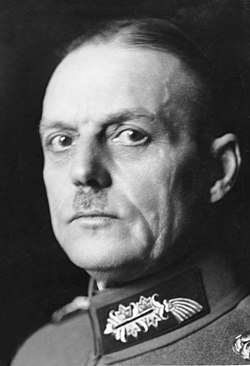
The Ardennes Counteroffensive, commonly known as the Battle of the Bulge , was a massive military operation undertaken by Nazi Germany in southern Belgium and northern Luxembourg which lasted from 16 December 1944 until 25 January 1945. The intent of the offensive was to split the ground forces of the Western Allies from each other and encourage them to make peace with Germany, leaving all of Germany's military might to fight off the resurgent USSR.
Contents
- High-level orders of battle
- Axis
- Allies
- Axis forces
- Sixth Panzer Army (Northern Sector)
- Fifth Panzer Army (Central Sector)
- Seventh Army (Southern Sector)
- Luftwaffe
- Allied Forces
- British 21st Army Group
- U.S. 12th Army Group
- US Third Army
- Allied Air Forces
- Notes
- References
The operation was conceived entirely by German head of state and armed forces chief Adolf Hitler. The plan was vigorously opposed by the two ranking generals who would oversee the assault, who saw only a waste of men and material with little chance of success. The Führer dismissed all objections, convinced that the elite German forces would roll over the war-weary and/or inexperienced American formations in the Ardennes Forest and drive all the way to the English Channel port of Antwerp.
In order to mislead any Allied intelligence personnel who might discover the plan, it was given the defensive sounding name Wacht am Rhein, meaning "watch on the Rhine".
The order of battle presented here reflects a point near the end of the campaign. As with any large army organization in extended combat, forces and their assignments shifted over the course of the battle. For example, when the German attack began on 16 December, the US 7th Armored Division was assigned to XIII Corps, US Ninth Army, 12th Army Group. Later that day, its alignment became VIII Corps, US First Army, 12th Army Group. On 20 December, the alignment switched to XVIII Corps, US First Army, 12th Army Group — and later that day to XVIII Corps, US First Army, 21st Army Group. On 18 January 1945, the alignment changed one last time, to XVIII Corps, US First Army, 12th Army Group — as it is given in the following hierarchy. This OOB — specifically, at a point near the end of the battle, which lasted from 16 December 1944 until 25 January 1945.
See for Allied and German Orders of Battle: December 1944 & January 1945: (Tucker-Jones pp 263–287)















